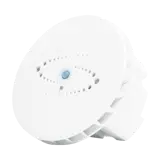
A Complete Guide to Vape Detectors
Vape detectors are used to identify and deter vaping in places like schools and businesses. They offer real-time alerts to enhance safety. In this article, we’ll cover their functions, how they operate, and the benefits they offer.
Key Takeaways
- Vape detectors are specialized sensors designed to detect vaping activities by identifying smaller particles and specific gasses, ensuring safety in environments where vaping is prohibited.
-
Sensitivity and accuracy in vape detection systems are crucial for reliable monitoring, significantly affecting their effectiveness in maintaining smoke-free environments and complying with regulations.
-
Various industries, including schools, healthcare, and commercial properties are benefiting from vape detection systems, leading to significant reductions in vaping incidents and enhancing overall wellbeing.
What are Vape Detectors?
Vape detectors (also known as vape sensors or nicotine detectors) are specialized devices used to detect vaping and smoking in restricted areas. They can identify various substances, including THC, CBD, nicotine, and vape particles. These detectors help maintain a smoke-free environment by identifying offenders and deterring vaping activities.
Typically, vape detectors are installed in schools, hotels, businesses, and other locations where vaping is prohibited. These sensors require a constant power source, either from a battery or wired connection. They play a crucial role in areas prone to vaping violations, helping to detect vaping incidents and enforce policies against e-cigarette use.
Understanding the mechanics and features of vape detectors enables stakeholders to make informed decisions about incorporating these devices into their safety protocols. Vape detectors not only help in detecting vape smoke but also provide real-time alerts and monitoring, ensuring quick responses to detected incidents.

How vape detectors work
Vape detectors are specifically designed to detect vaping activities by identifying smaller and less dense particles, unlike traditional smoke detectors that target larger particles. These detectors typically use two primary types of sensors:
- Particulate sensors that detect small particles.
- Gas sensors that identify specific gasses emitted from e-cigarettes and vapes.
These devices can also monitor air quality by checking for pollutants like carbon monoxide, particulate matter, and volatile organic compounds. Integration with IoT technologies enables these devices to offer real-time alerts and notifications, enhancing responses to vaping incidents.
1. Standalone vape detectors
Description: These are typically small, self-contained units that are easy to install. They often plug directly into a wall outlet and can be used to monitor a specific area like a bathroom, restroom, or hallway.
Pros: Simple to set up, cost-effective, and suitable for smaller spaces.
Cons: Limited coverage, may require multiple units for larger areas.
2. Networked vape detectors
Description: These detectors connect to a central monitoring system via Wi-Fi or Ethernet. This allows for real-time monitoring of multiple detectors across a larger area, such as a school, office building, or industrial facility.
Pros: Comprehensive coverage, centralized data monitoring, remote access and control, potential for integration with other security systems.
Cons: Higher initial cost, more complex installation, potential for network connectivity issues.
3. Multi-Sensor vape detectors
Description: These advanced detectors go beyond just detecting vape smoke. They incorporate multiple sensors to monitor various environmental factors and potential threats:
- Vaping Detection: Primarily designed to detect the presence of vape aerosols.
Aggression Detection: Some models can detect sounds of aggression, such as shouting or breaking glass. - Occupancy Detection: Can sense the presence or absence of people in a specific area.
Temperature and Humidity Monitoring: Can detect sudden changes in temperature or humidity, which may indicate potential issues. - Air Quality Monitoring: May include sensors for detecting carbon dioxide (CO2) levels, volatile organic compounds (VOCs), and particulate matter.
Pros: Enhanced security and safety, improved situational awareness, valuable data insights.
Cons: Higher cost, more complex to configure and maintain.
4. Wireless vs Wired Detectors
Wireless:
Pros: Easy and flexible installation, no need for extensive wiring, suitable for areas with limited access to power outlets.
Cons: Reliance on battery power, potential for interference or signal loss, battery replacement requirements.
Wired:
Pros: Consistent power supply, no battery concerns, these are generally considered more reliable and stable.
Cons: More complex installation, requires careful planning and wiring, may not be suitable for all locations.
By understanding the various types of vape detectors, organizations can choose the most appropriate solution based on their specific needs, budget, and the size and complexity of the area that is to be monitored.
Key features of vape detectors
Sensitivity and accuracy are critical for effective vape detection to ensure reliable monitoring of vaping activities. Due to the varying particulate emissions from different e-cigarette devices, specialized sensors are necessary for accurate detection. Vape detectors are equipped to provide real-time alerts, enhancing security response times in monitored areas.
Additionally, vape detectors can monitor environmental factors such as temperature and humidity, contributing to overall safety. Some advanced models can even detect aggressive behaviors such as shouting, noises such as breaking glass or gunshots, tampering, occupancy, and light levels.
Sensitivity and Accuracy Considerations:
- Detection range: Ensure the sensor covers the intended space effectively.
- False positives: Factors such as aerosol sprays, steam, and dust can interfere with vape detectors.
- Placement: Proper installation in high-risk areas enhances accuracy.
Installation and placement considerations
Proper placement is crucial for the effectiveness of vape detectors. Consider these tips:
- Install detectors in high-risk areas such as restrooms, locker rooms, and hallways.
- It is suggested to maintain a coverage area of approximately 12 x 12 feet per sensor for optimal performance.
- Avoid installing near vents or direct airflow paths to minimize false readings.
Consulting manufacturers can help facility managers determine the optimal placement for effective monitoring.
Addressing common concerns
How accurate are vape detectors?
Vape detectors are designed with high accuracy, but factors such as airflow, humidity, and sensor placement can impact their effectiveness. Regular maintenance and calibration are essential to ensure continued accuracy.
What triggers vape detectors?
Vape detectors are designed to identify the presence of vaping substances in the air. However, they can sometimes be triggered by other factors, leading to false positives. Here's a breakdown of the commonly reported triggers:
- Aerosol Sprays: Products like hairspray, perfume, and air fresheners release fine particles into the air that can mimic the presence of vape aerosols, potentially triggering the detector.
- Steam from Showers or Cooking: Steam from showers, hot water, or cooking can create a humid environment and release small water droplets into the air. These droplets can sometimes be misinterpreted by the detector as vape particles.
- High Humidity Levels: High humidity can increase the overall moisture content in the air, making it more difficult for the detector to accurately distinguish between vape aerosols and other airborne particles.
- Dust and Other Particles: Excessive dust, pollen, or other airborne particles can also trigger false alarms, especially in poorly ventilated areas.
Guidance for minimizing false alarms
1. Advanced Filtering Capabilities:
-
- Modern vape detectors utilize sophisticated algorithms and sensors to differentiate between vape aerosols and other substances.
- Look for detectors with features like:
- Particle Size Discrimination: These detectors can distinguish between the size and type of particles, focusing on the specific particle sizes associated with vape aerosols.
- Chemical Analysis: Some detectors can analyze the chemical composition of the air, identifying the presence of specific chemicals found in vape fluids.
- Machine Learning: Advanced detectors use machine learning algorithms to learn and adapt to the specific environment, reducing the likelihood of false alarms from common triggers.
2. Proper Placement and Maintenance:
- Install detectors in well-ventilated areas, away from sources of steam, aerosols, and excessive dust.
- Regularly clean the detectors to prevent dust buildup, which can interfere with sensor performance.
- Follow the manufacturer's instructions for proper installation and maintenance.
By understanding the potential triggers and choosing detectors with advanced filtering capabilities, you can minimize false alarms and ensure the effective detection of vaping activities in designated areas.
Disclaimer: This information is for general knowledge and guidance only. Always refer to the manufacturer's instructions for the most accurate and reliable information regarding the installation and operation of vape detectors.
Can vape detectors be tampered with?
Modern vape detectors come equipped with tamper-resistant features that send alerts if the device is moved or disabled. Installing detectors in discreet locations can also prevent tampering.
Cost considerations
Cost Considerations for Vape Detectors
The cost of implementing a vape detection system can vary significantly depending on several factors:
- Number of Units Required:
- The size of the area to be monitored directly impacts the number of detectors needed.
- Larger areas naturally require more units for adequate coverage, significantly increasing the upfront cost.
- Type of Detectors:
- Basic standalone units are generally more affordable than advanced multi-sensor detectors with features like aggression detection, air quality monitoring, and network connectivity.
- Networked systems typically have higher initial costs due to the infrastructure required for data transmission and centralized monitoring.
- Installation Costs:
- Professional installation can add a substantial cost to the overall project, especially for complex systems or large-scale deployments.
- DIY installation can be more cost-effective but may require technical expertise and could potentially void warranties.
- Maintenance Expenses:
- Ongoing maintenance may include:
- Regular cleaning and calibration of the detectors.
- Battery replacements for wireless models.
- Software updates and system upgrades for networked systems.
- Ongoing maintenance may include:
- Subscription-Based Monitoring Services:
- Some systems require ongoing subscription fees for:
- Data storage and analysis.
- Remote monitoring and alerts.
- Software updates and technical support.
- Some systems require ongoing subscription fees for:
Industries Benefiting from Vape Detection Systems
Various industries are increasingly adopting vape detection systems to enhance safety and compliance:
Schools and Educational Institutions
Vape detection systems in schools and educational institutions have led to a notable decrease in vaping incidents, helping maintain a safe learning environment.
Commercial and Residential Properties
Businesses and property managers use vape detectors to ensure compliance with no-smoking policies and maintain property value.
Healthcare Facilities
Hospitals and clinics benefit from vape detectors to maintain a healthy environment for patients and staff.
Public Spaces
Vape detectors in public places help enforce smoking bans and promote community wellbeing.

An ICT Solution for Vape Detection
Integrating vape detectors with existing security systems is essential for comprehensive monitoring and enhancing overall safety. Combining vape detection with broader security technologies can provide a more complete visibility of incidents and streamline the response process.
An ICT Protege system is a reliable solution for K-12 and higher educational institutions, allowing security and school management to seamlessly adapt their systems to emerging threats. To tackle the rising vaping epidemic, Protege can integrate with third-party technologies that provide advanced vape detection sensors.
The Halo Smart senor, a multi-sensor device, can detect vape, smoke, chemical presence, as well as monitor changes in air quality. Ideal for school restrooms, hotel rooms or even executive board rooms due to HALO's highest level of privacy protection.
Combining Protege with a third-party sensor, such as the Halo Smart Sensors used in U.S. schools, staff can be notified within the status pages and floor plans of the Protege system, and even receive push notifications right to their phones. This integration offers a seamless solution for access control, security, and wellbeing.
Article Summary
Vape detectors play a crucial role in maintaining safety and compliance in various settings, from schools to commercial properties and public spaces. By understanding how these devices work, the importance of sensitivity and accuracy, and the benefits they offer to different industries, stakeholders can make informed decisions about implementing vape detection solutions. The success stories shared highlight the positive impact of these systems, inspiring readers to consider their adoption for enhancing safety and policy enforcement.

Conclusion
Vape detectors play a crucial role in maintaining safety and compliance in various settings, from schools to commercial properties and public spaces. By understanding how these devices work, their sensitivity and accuracy, and their benefits to different industries, stakeholders can make informed decisions about implementing vape detection solutions.








